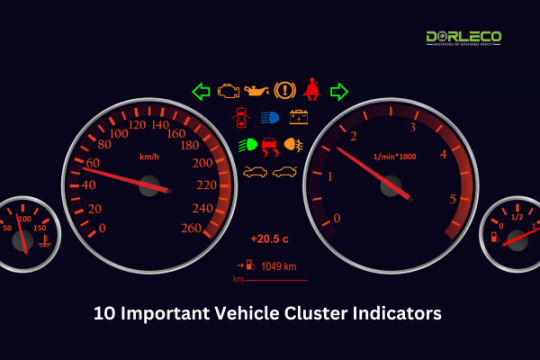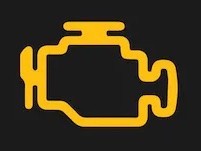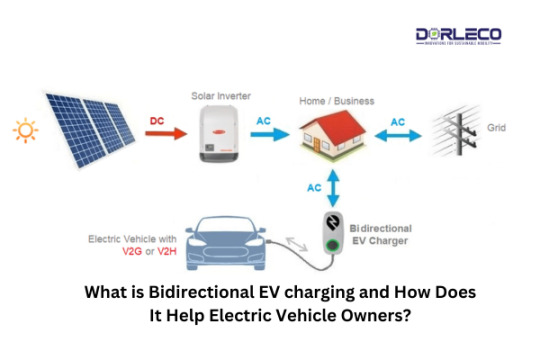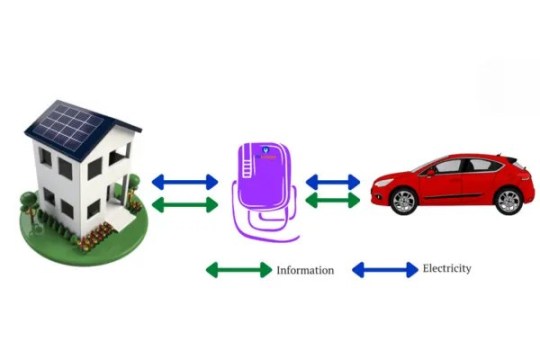#VehicletoGrid
Text
10 Important Vehicle Cluster Indicators
February 8, 2024
by dorleco
with no comment
Control Systems
Edit

Introduction
Vehicle Cluster Indicators
Potential problems with the vehicle and safety concerns are indicated by warning lights in the instrument cluster. Many of them are on our list, along with their definitions.
Your car’s warning lights are all on when you turn it on. It’s merely a system self-check, and they rapidly go out, so don’t panic. If they appear when you’re driving, here’s what you should know about Vehicle Cluster Indicators.
1. Engine Temperature
What does it look like?

How important/critical is this alert/symbol?
High.
What does that signify?
Your engine is overheating if the warning light appears or if the gauge needle goes into the red area. Usually, there’s not enough coolant leaking from a head gasket that’s malfunctioning, a broken hose, or a damaged radiator. Another possibility is a broken water pump that isn’t circulating coolant via the engine.
When the light turns on, what should you do?
As soon as it is safe to do so, stop, and turn off the engine. An engine that has overheated can sustain disastrous harm. Get the car towed to a repair facility.
2. Oil Pressure
What does it look like?

A can of red oil.
How important/critical is this alert/symbol?
High
What does that signify?
Either there isn’t enough oil in your engine or the oil pump isn’t forcing oil into the engine.
When the light turns on, what should you do?
Pull over and turn the engine off as quickly as you can. Engine damage that cannot be repaired might result from oil starvation. Get the car towed to a repair facility. Additionally, some cars feature an amber oil can serving as a “low oil” warning. It’s not an emergency if it turns on, but you should add oil right away.
3. Battery/Charging System
What does it look like?

How important/critical is this alert/symbol?
High.
What does that signify?
The battery’s primary task is to start the engine. Subsequently, the charging mechanism replenishes the battery and supplies electricity for the ignition, lights, and other uses. When the gauge drops below 13 volts or the warning light illuminates, the charging system isn’t functioning correctly. This can be an indication of an alternator failure.
When the light turns on, what should you do?
The car can operate on its battery, but it won’t last very long if the charging mechanism malfunctions. After turning off all unnecessary appliances like the phone charger and climate fan, head to the nearest repair shop. Increasing the battery won’t help if the car breaks down; it will only run for a short while before stopping again. A tow is required.
4. Check Engine Light
What does it look like?

How important/critical is this alert/symbol?
From moderate to high.
How significant or vital is this warning or icon?
Medium to high.
What does that signify?
This suggests that there may be an issue with the fuel, ignition, or pollution control systems of the car. Minor problems may include a loose fuel cap (some cars even come with a distinct “tighten cap” light), problems with the oxygen sensor, fuel injectors, catalytic converter, or other parts.
When the light turns on, what should you do?
Make an appointment for a service appointment to have the light checked if it is solid amber and the car is operating normally. Reduce your speed and take the car in for repair as soon as possible if it is losing power, running rough, or has an amber or red flashing light. There’s a chance that the issue will harm your pricey catalytic converter.
5. Tire Pressure Monitoring System (TPMS)
What does it look like?

How important/critical is this alert/symbol?
Medium.
What does that signify?
When a tire deflates to roughly 25 to 30 percent of its optimum pressure, the TPMS warning light appears.
When the light turns on, what should you do?
Should you possess a readout, it will indicate which tire is low; however, if it’s merely a light, you’ll need to examine each to determine which one it is. According to the owner’s manual or a chart on the driver’s door jamb, fill the tire to the proper pressure.
6. Brakes and Anti-Lock Brakes (ABS)
What does it look like?

How important/critical is this alert/symbol?
Medium to high.
What does that signify?
When brake pads are dangerously worn or there is not enough brake fluid, the brake light alerts you to the problem. Certain cars may have a parking brake warning light that illuminates when the brake is applied and turns off when the brake is released. If the light illuminates in any other way, there may be an issue. The ABS alert indicates that the anti-lock brakes aren’t working properly. In a panic stop, the ABS light will also momentarily illuminate; nevertheless, this signifies that it is functioning properly and does not signal a fault.
When the light turns on, what should you do?
Seek immediate auto repair, particularly if the brake pedal seems spongy or depresses more easily than normal, if the stopping distance is increased, or if the brakes grind or squeak.
Brakes and Anti-Lock Brakes
7. Traction Control and Electronic Stability Control (ESC)
What does it look like?

How important/critical is this alert/symbol?
From low to medium.
What does that signify?
Traction control applies the brake when one tire spins on a slick surface to help the other wheel get more grip. To help straighten the car, electric stability control applies brakes to the appropriate wheels when it senses a skid.
When the light turns on, what should you do?
When either system is in operation, the light momentarily glows or flashes, mostly to alert drivers to slow down. If you want the wheels to spin to help you get out of deep snow, you can temporarily disable the traction control. A warning that the traction control is deactivated will appear, prompting you to put it back on. When you’re driving normally and the traction or stability control warning light appears, there’s an issue with the system and it needs to be serviced.
8. Airbag Warning
What does it look like?

How important/critical is this alert/symbol?
Low to high.
What does that signify?
The airbag system is malfunctioning, as shown by the red symbol. When no one is occupying the front passenger seat, certain cars have an amber light that flashes to let you know that the passenger airbag isn’t necessary and won’t pop in an accident.
When the light turns on, what should you do?
If the light is red, have the car checked as soon as possible. In an accident, the airbags might not go off or activate while you’re driving. Unless it remains activated while an individual is seated, the amber airbag poses no threat. That might indicate a problem, and in the event of a crash, it might not deploy.
Check here for more Vehicle Cluster Indicators
9. Warning for Power Steering
What does it look like?

How important/critical is this alert/symbol?
High.
What does that signify?
This suggests that there is a power steering issue. A hydraulic system with low power steering fluid or an electrical problem with electric power steering could be the cause of this.
When the light turns on, what should you do?
Go as quickly as you can to a repair shop. If the power steering system breaks, you can still manage the car, but it will be extremely challenging.
10. Low Fuel Warning Light
How does it appear?

How important/critical is this alert/symbol?
Medium.
What does that signify?
You may have between 10 and 15 percent of petrol remaining in your tank when the light first appears, depending on your car.
When the light turns on, what should you do?
Not just because you don’t want to walk home, stop and fill up. Gasoline keeps the majority of gasoline pumps cool, which are located inside the tank. Running low puts a lot of strain on the pump and may reduce its longevity.
Conclusion:
It is clear from examining the ten most significant Vehicle Cluster Indicators that each one is essential to preserving the vehicle’s longevity, performance, and safety. These signs serve as early warning systems that enable drivers to take prompt action, from checking the health of the engine to making sure the tires are properly inflated and warning of possible problems. Through timely resolution of difficulties indicated by these signs, drivers can minimize fuel efficiency, avert costly repairs, and prevent accidents.
In conclusion, proper car ownership requires paying close attention to dashboard signs. Keeping an eye on these signs and taking quick action to fix any problems they point out can make driving safer, more dependable, and smoother. In the end, recognizing and reacting to these cues is essential to guaranteeing the driver’s safety as well as the best possible operation of the car.
#ADAS#VCU#Powertrains#EVs#EVCharging#VehicleClusterIndicators#Dorleco#Indicators#CAN#ElectricVehicles#VehicletoGrid
0 notes
Video
youtube
Vehicle to grid (V2G) powered by renewable energy sources
0 notes
Photo

Please checkout my final video review Fully Charged Live 2019 - Part3 ! youtu.be/KJHdetUf6Es @bobbyllew @fullychargeddan @fullychargedshow @inksharkman @carpervert #v2g #vehicletogrid (at Silverstone) https://www.instagram.com/p/B4A6zP2nkHY/?igshid=ust9452pimec
0 notes
Photo

Post-Buyout, Conergy To Focus On Australian Solar By Guest Contributor The Singapore-based solar developer behind one of Australia's first combined large-scale solar and lithium-ion battery storage projects, Conergy, has been bought out by a group of funds managed by Tennenbaum Capital Partners and Goldman Sachs…
#alternative energy#amp#battery#car#electric#energy#european#extends#life#owners#pays#plan#renewable energy#vehicletogrid
1 note
·
View note
Text
Why vehicle-to-grid charging could be the cheapest way to secure renewable energy
Why vehicle-to-grid charging could be the cheapest way to secure renewable energy
The UK electricity system is undergoing significant and rapid change. It has the world’s largest installed capacity of offshore wind, has effectively stopped generating electricity from coal, and has recorded a 20% drop in demand since the start of the COVID-19 pandemic.
However, this transition from traditional, reliable coal to weather-dependent wind and solar generation brings with it…
View On WordPress
0 notes
Photo

[#instantTech] NAVYA, leader du véhicule autonome 100% électrique, robotisé et sans conducteur. Intervention humaine en cas d’obstacle, elle se conduit avec une manette #Xbox #microsoft 😎 👌le véhicule est équipé de capteurs de dernière génération : Lidars, caméras, GPS RTK, IMU et odométrie. Avec l’arrivée de la 5G #navya n’a pas fini de faire parler d’elle. . . . . . . . . . . #pic #tech #technology #mobiliteelectrique #voitureautonome #IoT #instatech #AutonomsAreGo #vehicletogrid #autonomouscars #connectedcar #autonomy2017 #vehiculedufutur #mobiliteintelligente
#instatech#connectedcar#autonomy2017#mobiliteelectrique#mobiliteintelligente#autonomsarego#technology#tech#vehicletogrid#microsoft#navya#instanttech#iot#xbox#voitureautonome#vehiculedufutur#autonomouscars#pic
0 notes
Link
0 notes
Text
Global Vehicle-to-Grid (V2G) Market - Industry Analysis, Size, Share, Growth, Trends and Forecast 2020-2025
Summary – A new market study, “ Global Vehicle-to-Grid (V2G) Market - Industry Analysis, Size, Share, Growth, Trends and Forecast 2020-2025 ” has been featured on WiseGuyReports.
Vehicle-to-grid (V2G) describes a system in which plug-in electric vehicles, such as electric cars (BEVs) and plug-in hybrids (PHEVs), communicate with the power grid to sell demand response services by either delivering electricity into the grid or by throttling their charging rate.
Large-scale electric vehicle ordered charging can optimize power system operation, reduce peak loads, thus improving the operation safety and economy of power system. Compared with the traditional fuel vehicles, electric vehicles can greatly reduce primary energy consumption and greenhouse gas emissions.
Many countries have set objectives to expand the EV market in the coming decades, and each has taken a different approach to the policy enablers that they hope will help stimulate the market in the near term. Their motivations are similar: to improve air quality in vehicle-dense urban areas, to reduce transportation sector emissions of GHGs, and to achieve greater energy independence by reducing foreign oil imports.
Shortcomings in vehicle uptake have been feared by many to be the result of driver anxiety about vehicle range. Frequently, policy proposals to solve vehicle range issues call for networks of high capacity charging stations. In theory, giving drivers the ability to charge vehicles on-the-go could reduce range anxiety and mimic the refueling infrastructure to which drivers of gasoline-powered cars have become accustomed.
Also Read : https://www.newsmaker.com.au/news/378026/vehicletogrid-v2g-market-2020-global-share-trend-segmentation-analysis-and-forecast-to-2026#.Xyr8wygzaM8
The costs of driver adaptation underlie the challenge of stimulating EV market growth. Within the technical constraints of today’s vehicles, there is no way to meet all drivers’ vehicle range requirements for all trips. Drivers may be willing to find alternate modes of transportation, such as public transit or car rentals, if they are sufficiently compensated for the inconvenience. The question is: what is the required compensation, and where in the economic equation can it be captured?
Global Vehicle-to-Grid (V2G) market size will increase to xx Million US$ by 2025, from xx Million US$ in 2018, at a CAGR of xx% during the forecast period. In this study, 2018 has been considered as the base year and 2019 to 2025 as the forecast period to estimate the market size for Vehicle-to-Grid (V2G).
This report researches the worldwide Vehicle-to-Grid (V2G) market size (value, capacity, production and consumption) in key regions like United States, Europe, Asia Pacific (China, Japan) and other regions.
This study categorizes the global Vehicle-to-Grid (V2G) breakdown data by manufacturers, region, type and application, also analyzes the market status, market share, growth rate, future trends, market drivers, opportunities and challenges, risks and entry barriers, sales channels, distributors and Porter's Five Forces Analysis.
The following manufacturers are covered in this report:
AC Propulsion
Corinex
Coritech
EnBW
Endesa
EnerDel
EV Grid
Hitachi
Next Energy
NRG Energy
PG&E
Vehicle-to-Grid (V2G) Breakdown Data by Type
Unidirectional V2G
Bidirectional V2G
Vehicle-to-Grid (V2G) Breakdown Data by Application
Peak power sales
Spinning reserves
Base load power
Peak power as a form of direct load control (DLC)
Peak power to reduce demand charges
Reactive power
Vehicle-to-Grid (V2G) Production Breakdown Data by Region
United States
Europe
China
Japan
Other Regions
Vehicle-to-Grid (V2G) Consumption Breakdown Data by Region
North America
United States
Canada
Mexico
Asia-Pacific
China
India
Japan
South Korea
Australia
Indonesia
Malaysia
Philippines
Thailand
Vietnam
Europe
Germany
France
UK
Italy
Russia
Rest of Europe
Central & South America
Brazil
Rest of South America
Middle East & Africa
GCC Countries
Turkey
Egypt
South Africa
Rest of Middle East & Africa
The study objectives are:
To analyze and research the global Vehicle-to-Grid (V2G) capacity, production, value, consumption, status and forecast;
To focus on the key Vehicle-to-Grid (V2G) manufacturers and study the capacity, production, value, market share and development plans in next few years.
To focuses on the global key manufacturers, to define, describe and analyze the market competition landscape, SWOT analysis.
To define, describe and forecast the market by type, application and region.
To analyze the global and key regions market potential and advantage, opportunity and challenge, restraints and risks.
To identify significant trends and factors driving or inhibiting the market growth.
To analyze the opportunities in the market for stakeholders by identifying the high growth segments.
To strategically analyze each submarket with respect to individual growth trend and their contribution to the market.
To analyze competitive developments such as expansions, agreements, new product launches, and acquisitions in the market.
To strategically profile the key players and comprehensively analyze their growth strategies.
In this study, the years considered to estimate the market size of Vehicle-to-Grid (V2G) :
History Year: 2014-2018
Base Year: 2018
Estimated Year: 2019
Forecast Year 2019 to 2025
For the data information by region, company, type and application, 2018 is considered as the base year. Whenever data information was unavailable for the base year, the prior year has been considered.
FOR MORE DETAILS : https://www.wiseguyreports.com/reports/3753400-global-vehicle-to-grid-v2g-market-insights-forecast-to-2025
About Us:
Wise Guy Reports is part of the Wise Guy Research Consultants Pvt. Ltd. and offers premium progressive statistical surveying, market research reports, analysis & forecast data for industries and governments around the globe.
Contact Us:
NORAH TRENT
Ph: +162-825-80070 (US)
Ph: +44 2035002763 (UK)
0 notes
Link
The global Vehicle-to-Grid (V2G) market 2020-2026 research report offers an in-depth and thorough review, including an executive summary, description, and market scope. The Vehicle-to-Grid (V2G) market is segmented on the basis of technology
0 notes
Text
What is Bidirectional EV charging and How Does It Help Electric Vehicle Owners?
February 5, 2024
by dorleco
with no comment
Autonomous Vehicle Technology
Edit

Introduction
To reduce the risk of wildfires, millions of Californians have been without electricity during power safety shutdowns. The inability to use the electricity in their car batteries to power their houses or other essential loads has irritated a lot of electric vehicle (EV) owners. Even though their EV batteries could store energy, they could only use the electricity to run their car and not benefit from Bidirectional EV charging.
More and more EV users can power important loads from their automobiles or by acquiring a wall box unit. Systems for bidirectional charging have many advantages for both homes and utility corporations. When prospective solar consumers have inquiries, it’s important to comprehend what bidirectional chargers are and how they operate. Without depending on a battery, Bidirectional EV charging is a great way to have emergency power during blackouts.

Bidirectional EV charging: What Is It?
Bidirectional EV charging, as the name implies, is EV charging that uses two sources of energy: the grid for battery charging and the battery for delivering electricity for other loads when needed. By adopting bidirectional charging, an EV can assist in powering a residence, place of business, the utility grid, another vehicle, or particular loads.
The Nissan Leaf can now charge in both directions, but to use this electricity for domestic purposes, a power supply center needs to be installed in the house. A home’s electrical panel can receive 9.6 kW of power from the Ford 150 Lightning for a few days. A 100-amp circuit and Ford’s Charge Station Pro are needed for this setup. In addition, the Hyundai Ioniq 5 and 6 have 3.6 kW of electrical capacity.
How does it operate?
In contrast to standard unidirectional EV chargers that charge using AC, a bidirectional charger is a sophisticated EV charger that can charge in both directions. While this may seem fairly straightforward, it involves a complex power conversion process from AC (alternating current) to DC (direct current).
Bidirectional EV charging functions similarly to an inverter, transforming AC to DC while charging and the other way around when discharging, in contrast to conventional EV chargers. Nevertheless, only automobiles that are capable of two-way DC charging can be used with bidirectional chargers. Regretfully, only a very limited number of EVs are available at this time that can charge in both directions; the most well-known example is the Nissan Leaf from later models. Since bidirectional chargers use sophisticated power conversion devices to regulate the energy flow to and from the car, they are also significantly more expensive than standard EV chargers due to their increased sophistication.
Bidirectional EV chargers include technology to control loads and separate a residence from the grid during an outage, a process known as an island, in addition to providing power to a dwelling. Bidirectional inverters, which have been utilized for backup power in residential battery storage systems for more than ten years, and bidirectional EV chargers have a very similar core operating concept.
What Is the Process of Bidirectional EV charging?

While the car is charging, direct current (DC) voltage is created from alternating current (AC) power from the grid. After that, electric vehicle (EV) drivers can use the battery’s energy to power a house or replenish the electrical grid. The electricity must be transformed from DC to AC for this to occur. This is done by a converter in the car or in the charger itself.
One such item is the Wallbox Quasar, a household bidirectional DC charger. It has an app with some energy management functions and a CHAdeMO or CCS Type 1 connector.
When available, V2G capabilities allow EV batteries to be charged using renewable energy sources like solar and wind power. Next, when not in use, the EV uses its batteries to supplement the grid’s power supply, thereby lowering greenhouse gas emissions.
Vehicle To Home (V2H)
Using this method, an electric automobile can use its electrical panel to supply electricity to a house or business; this is particularly useful in the event of a power outage. Additionally, by utilizing their EV battery during periods of high energy demand and charging it during periods of cheaper electricity rates, households that pay time-of-use rates could save money.

Vehicle To Load (V2L)
A regular power outlet and an integrated DC-to-AC converter are features of vehicles equipped with V2L capability. It allows users to use the battery’s power by plugging in their loads. The Tesla Cybertruck, Hyundai Ioniq, Ford F150 Lightning, Kia EV6, and Rivian R1T are EVs that have these features.
Vehicle To Vehicle (V2V)
Sadly, the range of EVs limits how far they can go between charges. The range of the car is affected by the EV battery’s capacity, the vehicle’s efficiency, and the outside temperature. Because V2V charging allows one EV to supply some power to another, it can help alleviate range anxiety.
While several automakers are working on this functionality, it is currently limited to the Ford F150 Lightning and Lucid Air.
What Advantages Does Bidirectional Charging Offer?
Utility firms as well as EV drivers can benefit greatly from the ability to use the EV battery for other purposes. In reality, EVs may someday play a significant role in the decarbonization of the grid.
Possible Savings on Utility Bills
Should the nearby utility provide time-of-use rates, the cost of power varies throughout the day in response to demand. Energy costs are usually lowest in the middle of the night and greatest on weekday afternoons and early nights during the summer. Therefore, it is more cost-effective to supply power during periods of high demand and to charge during off-peak hours using solar panels or the grid.
Reserve Power for Outages
In the past year or so, there have been a few significant power outages, such as the Texas Power Crisis in 2021 and the public safety power shutdowns in California that left millions of people without power. During a utility outage, a complete home can be powered by EVs equipped with V2H capabilities. How many loads and how long an electric vehicle (EV) can power a home depends on its battery’s capacity and state of charge.
Energy Not Found in the Grid
EVs with V2L capabilities can plug into an outlet and power designated loads. When camping or in a place without utility electricity, this option might be quite helpful. On job sites, for instance, craftsmen can use power tools.
What Drawbacks Do Bidirectional EV Chargers Have?
Bidirectional EV charging has certain drawbacks in addition to its many benefits. Ongoing research can assist in overcoming these obstacles, though.
How EV Batteries Degrade:
Bidirectional EV charging’s frequent cycles of charge and discharge might hasten battery deterioration and shorten the batteries’ total life in electric vehicles.
The Price and Complexity:
Bidirectional EV charging adds complexity and expense to both the electric car and the charging station since it necessitates certain equipment and infrastructure.
Limited Interoperability of Vehicles:

Grid Stability Concerns:
The electric grid is more unpredictable when vehicles are charging in both directions since they can draw or return electricity at any time. Grid operators may find it difficult to maintain stability and dependability as a result.
Regulatory and Standardization Issues:
The broad adoption of electric vehicles may be slowed down by a lack of established protocols and standards for bidirectional charging, which can impair interoperability across various charging stations.
Energy Dissipations:
There are energy losses during the conversion and transfer of energy between the electric vehicle and the grid. When compared to unidirectional charging, this lowers the overall efficiency of bidirectional charging.
Which Electric Vehicles Can Be Charged Both Ways?
Bidirectional EV charging is a characteristic that only a tiny number of EVs on the US market offer; vehicle-to-grid is the most common. These cars are equipped with two-way charging:
Ford Lightning (models V2G, V2H, and V2V)
Genesis GV60 (V2L)
V2L Hyundai Ioniq 5
V2L Hyundai Ioniq 6
Kia EV6 (V2L)
Kia Niro (V2L)
Air Lucid (V2V)
The V2L Mitsubishi Outlander PHEV
Leaf from Nissan (V2H, V2G)
V2L Tesla Cybertruck
VW ID.4 (V2H)
FAQs Regarding Two-Way Charging
Discover the answers to some of the most frequently asked concerns concerning EV two-way charging by reading on.
What are the advantages for EV drivers of bi-directional charging?
Owners of electric vehicles gain power from bidirectional charging, which transforms their cars into adaptable energy sources. Beyond traditional charging, this technology allows owners to sell excess energy back to the grid, providing potential revenue. Bidirectional EV charging also makes it possible for electric cars to temporarily powerhouses or other EVs during emergencies.
Are bi-directional EV chargers installed in all-electric cars?
No, not every electric car on the road today has a Bidirectional EV charging capability. The design of the car and whether or not it has the required hardware and software for two-way energy transfer determine compatibility.
What problems do EV batteries have with bi-directional charging?
Because bidirectional charging increases the frequency of charge and discharge cycles, it may shorten the overall lifespan of batteries used in electric vehicles by accelerating battery degradation. The longevity of an EV battery will only be significantly impacted by heavy, frequent use, while battery degradation is negligible otherwise.
Can solar batteries be replaced by bi-directional EV chargers?
Although bidirectional charging gives electric cars a way to store extra energy for use at home, solar batteries are still necessary in some situations. The vehicle’s battery is the main component used in bidirectional charging, and it might not have enough capacity for large-scale energy storage. Because they are made to be stationary, solar batteries have greater storage capacity and are therefore more appropriate for storing solar panel energy to provide a steady and dependable power source. Additionally, because it can reduce their mobility, EV drivers might be reluctant to fully drain their batteries during blackouts.
Regarding bidirectional charging, what is true?
Bidirectional EV chargers allow power to flow in two directions, in contrast to standard EV charging systems, which only allow power to flow from a power source to the vehicle’s battery. It makes it possible for electric cars to transmit and receive energy, sharing electricity with other gadgets or even the utility grid.
Two-way Charging Could Revolutionize the Clean Energy Sector
The ability of electric vehicles to transfer excess energy to the grid, other vehicles, or residences could bring about a radical change in how energy is used. The interplay between electric vehicles and the energy ecosystem presents a dynamic and decentralized approach that can enhance grid management efficiency, increase resilience in the event of an outage, and potentially utilize electric vehicles as distributed energy resources, thereby contributing to the development of a more sustainable and adaptable energy landscape.
#ADAS#VCU#Powertrains#EVs#EVCharging#bidirectionalcharging#Dorleco#CANcommunication#CAN#ElectricVehicles#VehicletoGrid
0 notes
Video
youtube
Bidirectional charger working on V2G and G2V operation
#youtube#matlab_assignments matlab Simulink Vehicletogrid V2G G2VCONTROL ELECTRICVEHICLEPOWER MANAGEMENT BIDIRECTIONALBUCKBOOSTCONTROL
0 notes
Text
La Région #Occitanie déploie le projet « #Flexitanie » pour accélérer le #Vehicletogrid
Le 7 juillet, la Région Occitanie, l'Agence régionale de développement économique (Ad'Occ), l'Agence de la transition écologique (Ademe) et l'énergéticien EDF, ont lancé le projet baptisé « Flexitanie ». Il s'agit du premier projet, en Occitanie, visant à développer des solutions de recharge et de décharge des batteries des véhicules électriques dites « Vehicle-to-Grid » (V2G) ou « smart charging ».
0 notes
Photo

New Episode! The PlugSeeker has Vehicle to Grid Installed ! Part of an exciting new era of charging. Please RT. 25. Vehicle to Grid (V2G) Charger Installed! youtu.be/wAdiwl42_ec @bobbyllew @ovoenergy @fullychargeddan @elonmusk @Tesla #electriccars #vehicletogrid #v2g https://www.instagram.com/p/BzbgdYJHbQy/?igshid=isaudsvf5muc
0 notes
Text
Natural Gas-Fired Electricity Conversion Efficiency Grows as Coal Remains Stable
Natural Gas-Fired Electricity Conversion Efficiency Grows as Coal Remains Stable
By U.S. EIA: Today in Energy From 2006 to 2015, annual average heat rates of natural gas-fired electricity generators decreased 7% as heat rates of coal-fired electricity generators remained stable, increasing only 1%. Heat rates are calculated based on the amount of energy (measured in British thermal units) reported to EIA that was used to generate a unit of electricity. Lower […]
The post…
View On WordPress
#alternative energy#amp#battery#car#electric#energy#european#extends#life#owners#pays#plan#renewable energy#vehicletogrid
0 notes
Text
UK launches yet another vehicle-to-grid charging trial — but only for 100 Nissan drivers
UK launches yet another vehicle-to-grid charging trial — but only for 100 Nissan drivers
Credit:
photos.icons8.com – Edited
Powering your home using the energy stored in your electric vehicle (vehicle-to-grid) isn’t commonplace yet, but it could be if trials are successful.
Speaking of which, a UK power distribution firm, that manages the energy grid across West England and…
View On WordPress
0 notes